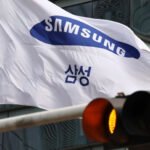Samsung’s musculoskeletal disorder prevention exercise center at its Giheung plant in Korea
Samsung Electronics Co., the world’s largest memory chipmaker, is striving to prevent musculoskeletal disorders (MSDs) at its workplaces to improve productivity by protecting its employees from the risk of work-related injuries.
The South Korean tech giant recently launched a task force led by the chief safety officers (CSOs) from the company’s Device Experience (DX) and Device Solutions (DS) divisions to address MSDs.
MSDs are injuries or pain in the human musculoskeletal system, including the joints, ligaments, muscles, nerves, tendons and structures that support limbs, neck and back.
A Samsung trainer helps an employee suffering from a musculoskeletal disorder exercise at the MSD prevention center at its Giheung plant
MSDs can arise from a sudden exertion, such as lifting a heavy object. They can also arise from making the same motions repeatedly, causing a repetitive strain, or from repeated exposure to force, vibration or awkward posture.
Examples of MSDs include carpal tunnel syndrome, tendinitis, back pain, tension neck syndrome and hand-arm vibration syndrome.
INDUSTRY LEADER
Industry officials said Samsung is already among the industry leaders with MSD prevention systems.
Samsung’s musculoskeletal disorder prevention exercise center at its Suwon plant
In its DS division, Samsung plans to double the automation rate of its wafer boxing system at the 200 mm wafer chip production line in Yongin, Gyeonggi Province, over the next few years.
The company recently introduced new wafer boxes, which are lighter and easier to handle, thus reducing the strain on workers’ wrists and fingers, on a test basis.
In the DX division, the company in June surveyed 1,200 tasks and processes at its facilities in Korea to detect factors that cause MSDs. It has found 38 processes at the Gumi plant that could pose musculoskeletal burdens and said it plans to improve the way its employees work by the end of this year.
SAMSUNG OPERATES 16 MSD PREVENTION CENTERS
The Korean chipmaker said it is also committed to actively treating employees suffering from MSDs.
Samsung’s MSD prevention exercise center at its Gumi plant
To relieve muscle fatigue and prevent MSDs, Samsung operates 16 musculoskeletal disorder prevention exercise centers nationwide.
Samsung said these centers are equipped with state-of-the-art medical equipment and exercise machines, including 3D body shape analysis systems, balance testing equipment, high-pressure oxygen tanks, Pilates machines, non-motorized treadmills and spinal muscle-strengthening devices. A total of 69 exercise instructors, certified as health exercise managers and sports instructors, work full-time at these centers.
For employees experiencing MSD-related pains, Samsung provides customized treatment through one-on-one care programs.
For those who are unable to visit the prevention centers, Samsung said it will send professional staff to workplaces to measure physical functions such as strength and joint flexibility and analyze body movements to offer personalized pain relief guidance.
By Jeong-Soo Hwang
hjs@hankyung.com
In-Soo Nam edited this article.














